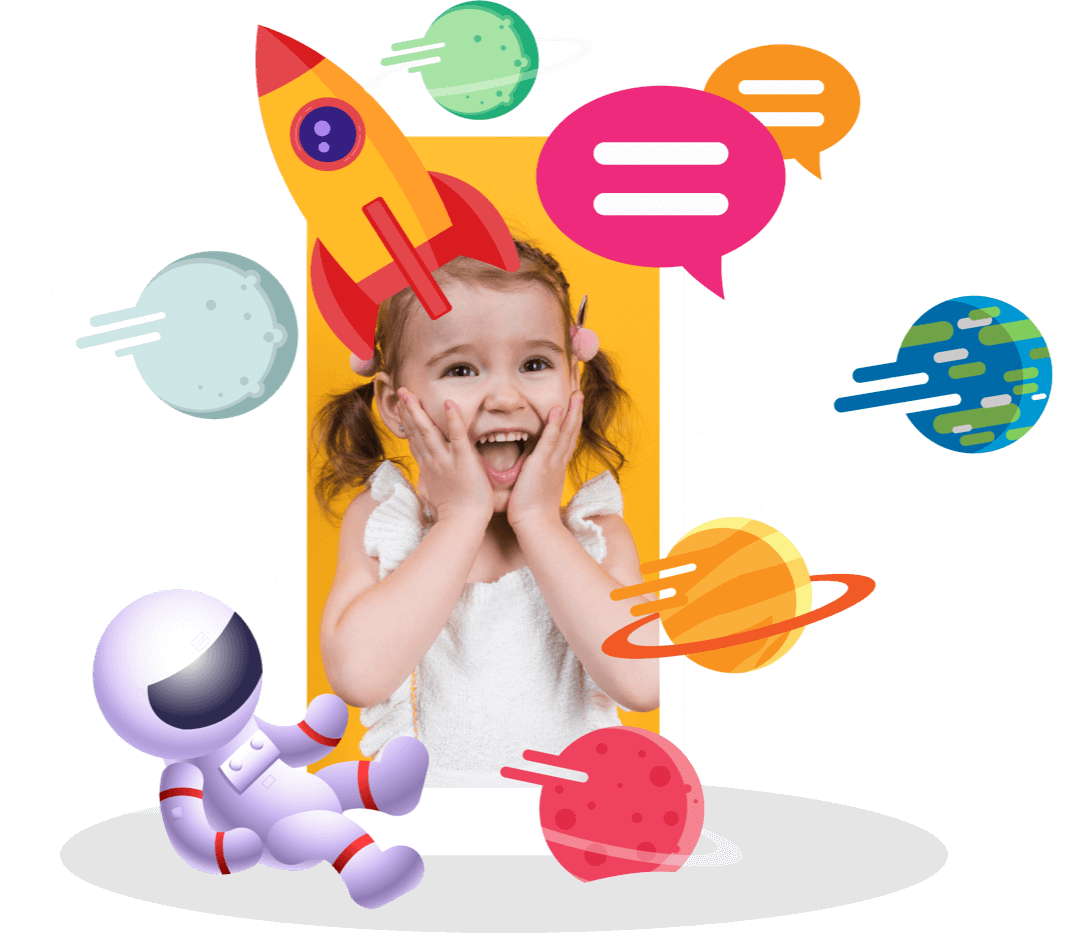Speech disabilities and language disorders often intersect, but they are unique in their own right. As parents or caregivers of kids with special needs, it’s crucial to grasp the nuances of each, ensuring your child gets the best possible support. This article aims to shed light on this topic.
What are Speech Disabilities?
Speech disabilities refer to difficulties in producing sounds correctly or fluently, or problems with voice quality. It impacts the way a person communicates daily. Imagine knowing what you want to say, but the words just won’t come out right? Frustrating, isn’t it?
Types of speech disabilities
Speech disabilities and impairments come in many different forms, affecting individuals in different ways. The following are some of the types of speech disabilities explained shortly.
Come along with 200k+ families!
Let's communicate better!
Download for Free.
Fluency disorder
Fluency disorder is characterized by disruptions in the flow of speech. An individual with fluency disorder might elongate a sound (like “sssssnake” for “snake”), repeat a sound or syllable (like “wa-wa-wa-water” for “water”), or experience unintended pauses. While these can happen to anyone occasionally, for someone with a fluency disorder, especially stuttering, it’s a consistent struggle. The person knows precisely what they want to say but faces interruptions in getting the words out smoothly.
Voice disorder
Your voice is like an orchestra, and every part of it needs to work harmoniously. However, a voice disorder disrupts this harmony. This can look like the pitch is too high or too low when compared to others of the same age, gender, or cultural background. Sometimes the voice might sound breathy, raspy, or strained. Picture a worn-out violin string – it doesn’t produce the right sound when played. Chronic hoarseness, vocal fatigue, or even pain when speaking are also common symptoms. Factors like vocal cord damage, tumors, or even certain behaviors, like excessive shouting, can lead to voice disorders.

Articulation disorder
Remember playing darts and missing the bullseye? That’s analogous to having an articulation disorder. It involves difficulties in pronouncing certain sounds, causing words to be slurred, omitted, substituted, or added. For instance, a child might say “wabbit” instead of “rabbit” or “thpoon” instead of “spoon.” The reasons can vary, from physical abnormalities like cleft palate to learned habits that just didn’t correct over time.
Language disorder
Language doesn’t just consist of words, it’s also about how the words are strung together. Putting words together in a sentence is a learned skill, and sometimes individuals with a language disorder may struggle with doing this. It could be difficult for individuals with language disorder to string together words to build sentences. They also can build sentences that are simpler compared to those built by their peers. Their vocabulary might be limited, or they might use words and phrases incorrectly. This isn’t about laziness or a lack of intelligence; it’s a genuine struggle with processing and producing language.
Receptive
It’s not just about the words, but how they’re strung together. Someone with a language disorder might find it hard to put words together into sentences, or the sentences they form may be simplistic compared to their peers. Their vocabulary might be limited, or they might use words and phrases incorrectly. This isn’t about laziness or a lack of intelligence; it’s a genuine struggle with processing and producing language, relating to the receptive language .
Expressive
Conversely, expressive disorders are like having a box full of puzzle pieces but not knowing how to fit them together. The ideas are there, waiting to be shared, but connecting them into coherent sentences is the obstacle. These children might have a limited vocabulary or rely heavily on generic words like “stuff” or “things.” They know what they want to express, but the words elude them, making conversations and storytelling challenging.
Understanding these speech disabilities provides a foundation for empathy and tailored support. Whether you’re a parent, caregiver, or educator, it’s about adapting and finding the tools to help these individuals find their voice.
Common causes and risk factors
Many factors can lead to speech and language disorders. It’s a blend of genetics, environmental factors, and sometimes, pure chance. Here’s a closer look:
Premature birth
Babies born before 37 weeks often face multiple challenges, one of which could be speech and language issues.
Genetic factors
Like eye or hair color, speech disorders can sometimes run in families.
Brain injury
Injuries, especially during crucial developmental years, can lead to speech or language issues.
Exposure to harmful substances
Alcohol or drugs during pregnancy can influence a child’s speech and language development.
Is a Speech Impediment Considered a Disability?
Defining disability in the context of speech impediments
Not every speech impediment is considered a disability. However, if it significantly interferes with daily communication, it may be classified as one.
Legal considerations and rights
In many jurisdictions, speech impediments that impact one’s ability to communicate or learn might fall under disability rights. It ensures access to equal opportunities and protections.
Speech and Language Disorder: Key Differences
Understanding speech disorders
These are issues with the “production” of sounds.
Understanding language disorders
This pertains to difficulty understanding or using words in context.

Language Disorder vs. Speech Disorder
In the vast area of communication, language and speech disorders present as intertwined threads, often mistaken for each other but holding distinct patterns and nuances. While speech disorders pertain to the physical act of voice production, like the clarity of pronunciation or rhythm of speaking, language disorders delve into the more intricate world of processing and conveying ideas.
Imagine having all the colors to paint but not knowing how to mix them to create the desired shade; that’s akin to having words but struggling to form coherent sentences, a hallmark of language disorders. On the other hand, speech disorders can be seen similar to having a slightly frayed brush, where the words are there, but their delivery is flawed. Recognizing the subtle dance between these two is pivotal for targeted therapeutic interventions and comprehensive understanding.
Overlapping symptoms and distinctions
While both deal with communication, speech is about how we say words, while language is about how we use these words to share ideas.
Diagnostic criteria and assessments
Specialists use various tools and observations to diagnose these disorders. One might involve analyzing how a child responds to instructions, while another might focus on how they pronounce certain words.
Speech Therapy and Special Education
In the realm of special education, speech therapy emerges as a cornerstone, bridging gaps and fostering communication growth for individuals with speech and language challenges. Speech-language pathologists work alongside educators, tailoring interventions that mesh seamlessly with educational curriculums.
Their combined efforts not only enhance the communicative abilities of these students but also bolster their confidence and self-esteem, equipping them to navigate the academic world and social landscapes with greater ease and efficacy. The synergy of speech therapy and special education showcases the profound impact of interdisciplinary approaches on holistic child development.
Educators, health professionals, and parents will work together to define special education eligibility and to create a unique special education plan called an Individualized Education Plan or IEP. It is also possible and sometimes logical to seek out alternative means of communication.
Role of speech therapy in special education settings
It’s immense! Speech therapists or pathologists work closely with special education professionals to design strategies and interventions to help children communicate better.
Understanding speech and language disorders is more than just deciphering terms. It’s about empathizing with the challenges many face daily and recognizing the significance of early interventions and therapies. By being informed, caregivers and parents can better advocate for their child’s needs and rights.
FAQs
What’s the primary difference between speech and language disorders?
Speech disorders are about sound production, while language disorders focus on understanding or using words in context.
Is stuttering a fluency disorder?
Yes, stuttering is the most common type of fluency disorder.
Are all speech impediments disabilities?
Not necessarily. They’re only considered disabilities if they significantly impede daily communication.
How can speech therapy help my child?
Speech therapists use various techniques to improve sound production, fluency, and language understanding and use.
Do genetics play a role in speech disorders?
Yes, in some cases, speech or language disorders can run in families.




